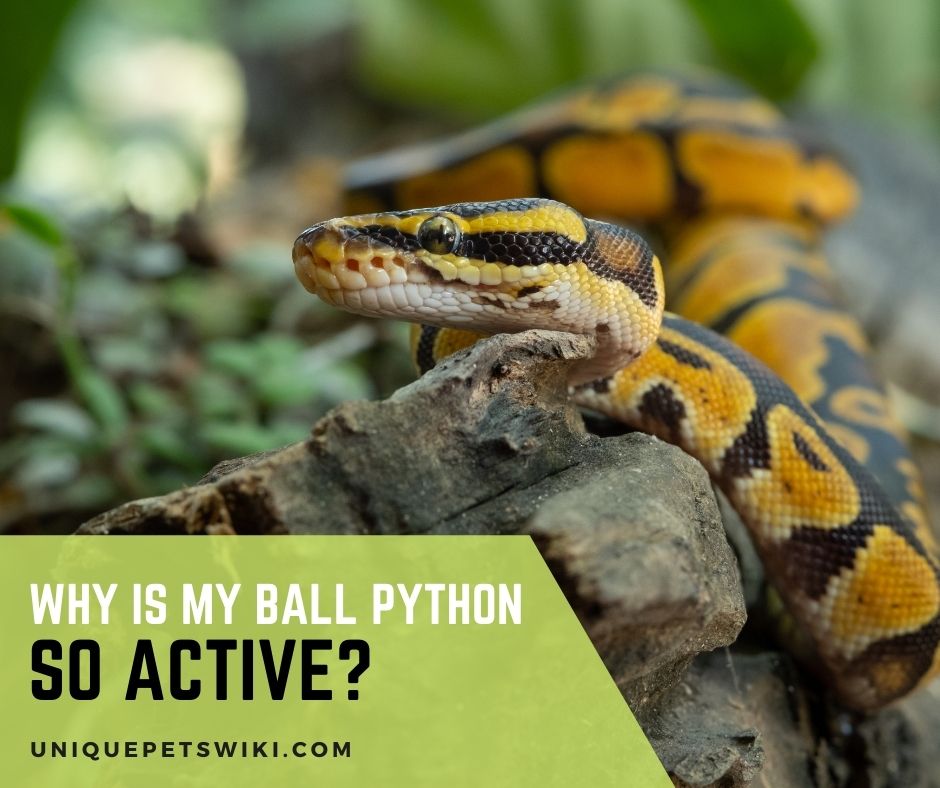Is your ball python behaving more restless than normal, or moving around more than usual?
But what are the reasons for your snake friend’s increased activity? “Is my snake okay?” “Why is my ball python so active?” and plenty more.
You’ve arrived at the right place! In this blog, we’ll go over all of the answers to your queries about Active Pythons, as well as how to keep them happy so that this behavior doesn’t happen again. So let’s get this ball rolling!
This article has been reviewed by Dr. Gospel. Read more about our knowledge control process here.
Contents
How Active are Ball Python In Captivity?
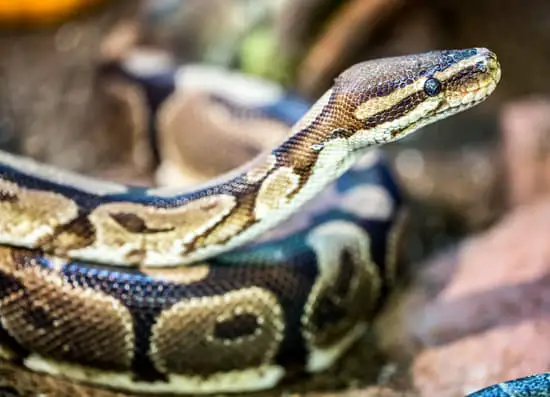
The activity of Ball Pythons depends on many factors such as the personality of the snake and their living conditions.
In general, they are active and move regularly if they are used to their tanks and your presence.
Ball pythons in captivity are involved in a variety of activities. If a ball Python is new with a tank or area, they will normally hide until they get a better understanding of it.
They’ll also grow more active if they’re used to seeing you and if you interact with them frequently. It also depends on their tank’s condition.
They will be seen examining their tank more frequently if the heat and humidity levels are in the right range.
Considering these factors, ball pythons are mainly nocturnal that is only seen outside of a hide on rare daytime occasions.
Why Is My Ball Python So Active?
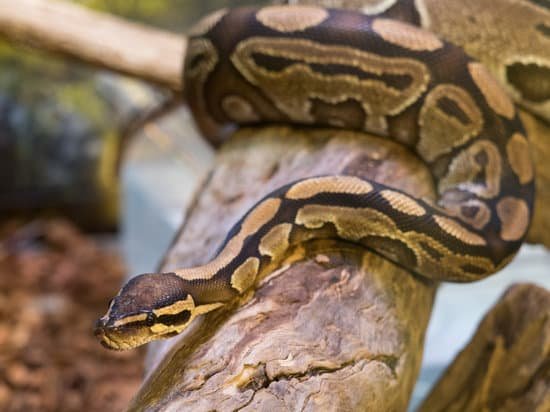
So, what’s the deal with my ball python’s strange attitude?
There are many reasons why your ball python appears to be really active.
Such as their enclosure is too small, temperature and humidity levels are incorrect, they have few hiding spaces, shedding problems, they’re hungry, looking for a mate, and the worst part is they’re trying to escape.
Anxiety, uneasiness in their tanks, lack of food, and a shortage of hiding places are examples of these factors.
There are a variety of reasons why you might be concerned, but you’ll soon understand that some of them are perfectly normal.
What needs to be done is to figure out what’s causing the problem and fix it as soon as feasible.
Enclosure Is Too Small
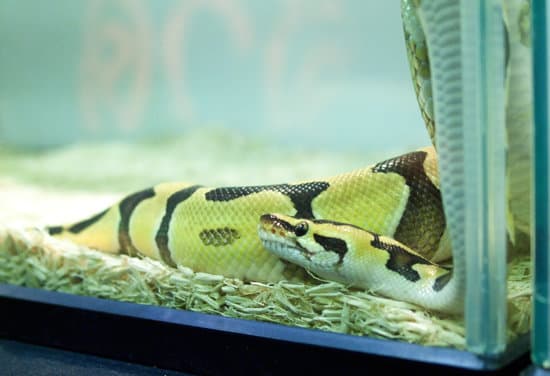
Beginner owners frequently purchase tanks that appear to be large but are actually little Ball Python tanks. This is a common error made by both new and experienced owners.
If their enclosures are too small, they have difficulty moving, which means they are going to try and try to move as they think that they are trapped and therefore unsatisfied with the current living conditions of the tank.
They’re going to be really active as this is an uncomfortable experience for them and they will try to move to places where they can move more freely.
One of the most important aspects of caring for a ball python is to provide them with suitable habitat that allows them to wander freely.
Ball pythons under 3 feet in length should be kept in a terrarium of 10 to 20 gallons.
Until your ball python grows to be 4 to 5 feet tall, it will need a 40-gallon tank with 2 to 3 feet of vertical climbing room.
Aggressiveness, such as fake attacking and hissing a little too often, a lack of appetite, and repeated efforts to escape, are signs that the enclosure is too small.
Though this is a common problem, it could cause serious repercussions.
If the problem is not resolved quickly, your python may lose appetite, grow agitated, and die sooner than expected.
To deal with this difficulty, one must first determine the length and age of their pet in order to determine the appropriate cage size.
REPTI ZOO Newly 67 Gallon Reptile Glass Terrarium, 2 in 1 Use 36″ x 24″ x 18″ Knock-Down Reptile Habitat Tank
- Made with quality thick and extremely high hardness tempered glass base for more safety; Tough top screen provide ventilation and allows good uvb and infrared penetration.
- There is mesh ventilation on left and right side of terrarium, these side mesh panels can be switched with glass panels, 2 in 1 use. On top and right have closable inlets for wires and tubing.
- Raised bottom frame is in order to fit a substrate heater; Waterproof bottom makes it to be used both as desert and rainforest terrarium.
- Double front doors can be opened separately, easy to feed your pet and prevent it escape.
- Easy to install or knock-down in 5 minutes with step by step instructions; Our glass terrariums are carefully packaged with double box of tough cardboard and thickened reinforced foam for transportation. IMPORTANT NOTICE: All glasses are upgraded to tempered glasses. DO NOT cut or punch any holes on the glass, otherwise it will be damaged.
Last update on 2022-12-29 / Affiliate links / Images from Amazon Product Advertising API
Temperatures and Humidity Are Incorrect
Another typical problem that owners make while keeping a Ball Python as a pet is failing to consider the temperature and humidity that their snake experiences.
You already know that Pythons thrives in high heat as they evolved in Africa which is a very hot and humid country.
The reason why humidity is very important for them is it’s how they stay hydrated.
Every time your snake flicks its tongue out, it is actually losing moisture and it needs to gain that back from the air.
Humidity ensures your snake stays hydrated, snakes are one of the many cold-blooded species, therefore the temperature is also very relevant to them.
Their bodies are influenced by the temperature of their surroundings.
Snakes can only maintain sufficient body heat for important components like digestion if the temperature is just right.
Examine your snake’s shredded scales to see if this is the cause of its heightened activity.
This must be a concern if their shredded scales are broken into pieces, snakes must shed their scales in order to keep their scales healthy.
Your snake will have shedding troubles if the temperature and humidity dip too low, but if the humidity is just right, your animal will shed naturally.
We have three options for dealing with this issue.
To maintain a hot temperature and a very humid environment, you can install an old-school bulb that emits heat, heat pads are the second option.
They’re inexpensive and perform excellently in the bottom of the enclosure. Finally, there’s the thermostat, the thermostat can be moved from the bottom to the top of the tank to distribute heat evenly.
Spraying water on the terrarium every 5 hours will produce a humid environment that your snake will like!
On average, a sweet spot for keeping your Ball Pythons humidity at around 60%. They can take higher for around 68%, and a little bit lower up to 55%. It all depends on your setup.
There are three ideal temperatures for your Ball Python. We have the ambient temperature, a cool temperature, and a hotspot also known as the “Basking Spot.”
For the basking spot, the temperature must be 88-95 degrees celsius. For Ambient temperature, it should always be around 83-87 degrees celsius. The cold spot can drop up to 79 degrees celsius.
Lack of Hiding Place
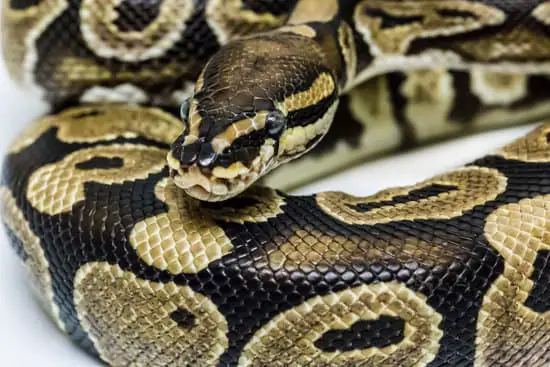
If the hiding places in Ball Pythons’ tanks are few, they feel uneasy, which is the cause of them seeming to be more active.
This is uncommon because dealers normally advise consumers to make sure they have a hiding location before purchasing a ball python.
Make sure that your Ball Python has some hiding spots. Ball pythons in the wild spent most of their time in some small hollows.
Not that they don’t go out, but they do spend a good amount of time in small hollows on the ground where they are feeling most safe and most comfortable.
So it is very very important that you try and replicate that as much as possible.
Hesitant mobility and strange sleeping habits might all be indicators that this is the cause of your snake’s increased activity.
Some risks associated with a lack of hiding place include a snake that is weaker and has a poor appetite most or all of the time.
To deal with this situation, we recommend providing two hides, one warmer and one cooler, so that your Python has a variety of hiding alternatives.
It is also a good idea to cover the sides and back of your terrarium with newspapers or a towel to keep your ball python safe.
Zoo Med Repti Cave for Reptiles
- This product is easy to use
- This product adds a great Value
- This product is Manufactured in United States
Last update on 2022-12-29 / Affiliate links / Images from Amazon Product Advertising API
Shedding Issues
When it comes to keeping a Ball Python, one of the most common concerns that owners face is shedding.
Shedding is what happens when a snake is growing. It’s a natural process and the snake does it ever since its born.
Shedding is an uncomfortable experience for snakes generally speaking, which makes them more active. Every time that the snake is growing, it sheds off the old layer of skin.
For the shedding process to be considered healthy, it must be one big beautiful piece of old skin.
Sometimes, you will see that snake shed in several smaller pieces, and usually, that would be a sign of the snake not being completely healthy.
It can be because the humidity and temperature of the terrarium are not right.
When this happens, your snake might die almost immediately but before that, it would make you worry as a snake parent as it would constantly move around the cage, with dim eyes.
You must ensure that your snake setup’s humidity and temperature are properly set.
So when it’s shedding time, they tend to be more active than usual as this is sometimes an uncomfortable experience for them.
Your Ball Python Is Hungry
Yes, hungry pythons can make them restless, because of course, who doesn’t?
Sometimes Ball Pythons are just hungry so they feel restless, which is completely normal. It may be because they didn’t like what you just fed them, or they’re growing at a rapid pace.
Feeding them different foods provides mental stimulation for the snake, it gives them a variety of different nutrients and gives them better gut content.
Long periods of time in front of the cage, continual hissing and flicking of the tongue, and wandering about the tank to “search” for prey are all symptoms that your python may be hungry and generating restlessness.
Hunger-related risks can make your snake sick as well as weaken it. Feed your hungry python a variety of meals, such as guinea pigs, frozen hamsters, mice, and rats, because these are more filling.
Babies and juvenile ball pythons are gonna eat about once a week, and as it gets older, you’re actually gonna slow that down to about every 10-14 days.
The size of the mice, rats, hamsters or any other food you feed your Ball Python should be approximately the same as the thickest region of their body.
Sign of Attempting to Escape
Snakes hide during the day and go out of their burrow at night.
Usually, pythons in captivity go out of their hides at night and will bring their headway up the terrarium, as though looking that they are trying to escape.
If they are not happy, used to, and satisfied with their tank setup, and the way you take care of them, they could attempt to escape which is the cause of their extra activity level.
This is uncommon for Ball Pythons, especially those who are new to captivity and the environment arrangement.
But this behavior actually means that they are only stretching and curious about their surroundings.
Although, when your Ball Python pushes you away when you handle it, hisses aggressively and loudly, moving a lot, as well as mock biting, these can be signs that your snake is stressed, and that is why it attempts to escape the terrarium.
To deal with this problem, make sure that you have the right habits with the right amount of temperature, humidity, food, and water, as well as hiding places.
You can also touch your ball python to destress it for 5 minutes a day as stress is one of the leading causes why your snake attempts to escape its cage.
Your Snake Is Looking for A Mate
Breeding season causes you’re Ball Python to look for a mate, hence its higher activity levels; since in the wild, these snakes move from place to place in order to look for a suitable partner.
This behavior can be seen as higher activity levels within captivity instead.
Breeding season for python normally takes place in the early springtime. In captivity, though, a snake might become irritated at any time of year.
Temperature plays a big role when your pet snake looks for a mate. Most owners change the terrarium’s temperature, dropping it down and tricking the snake that it’s mating season.
Male snakes begin hunting when they feel the urge to mate. They’ll explore their surroundings for pheromones emitted by a female snake.
Some signs that your pet might want to mate are restless, the head is always still and focused, and your snake is always ready to strike.
To deal with this problem, we recommend you mate your snake with the opposing gender in order to satisfy its needs.
What Happens If Ball Python Continues To Be Too Active?
There are no known negative effects of Ball Pythons continuing to be active unless the cause is from Shedding, Incorrect Temperatures, and Humidity, continued hunger, and signs of attempted escape.
Some negative effects can include them dying because of improper temperatures and humidity which has negative effects on their general health such as shedding problems, and these problems can lead to the immediate death of the python.
Hunger problems could also lead to unexpected passing away, these are the dangers if they grow or have continued activity levels.
If they are active and these are not the reasons, let them be, they might just be enjoying their new homes, however, if you’re worried that your ball Python continues to be active, it is best to have a veterinarian examine your snake.
FAQs
Why is my ball python moving so fast?
It’s entirely natural to have a fast-moving ball python. This indicates that they are at ease and active in their enclosure.
How can I calm my ball python down?
The easiest approach to quiet down your ball python is to return it to its cage and allow it alone to de-stress and regroup. Allow your pet to rest for a few days before handling him again.
How can you tell if a snake is unhappy?
Unhappy stress snakes are equal to stress snakes. Unfortunately, stress is very common in captive Ball Pythons. The cause for this is due to a number of factors, the first of which is an incorrect setup.
The second is excessive handling. When your pet engages in defensive and aggressive behavior, such as acting dead most of the time, refusing to eat, and striking its cage frequently, you may tell it is unhappy.
If your snake’s eyes are cloudier than usual, there’s another sign that it’s unhappy.
How often should I mist my ball python?
One of the most effective ways to enhance the humidity in your terrarium is to mist your ball python. To avoid infection or sickness, make sure that the bedding and your snake aren’t soaked.
Misting your snake once every two weeks is plenty to keep it happy and healthy!
Conclusion
Snakes roam around for a variety of reasons, and their activity levels keep changing throughout the day.
Because ball pythons are nocturnal creatures, they move around more at nighttime, which should be expected if you see it.
Although, if you keep a light on or turn night lights on in the area where they are housed, their understanding of timing may be thrown off.
So try to limit this and match their natural surroundings as much as possible.
During shedding and mating seasons, snakes may have more stamina and may move around more than regular, as shedding forces a snake to wiggle and press its body towards surfaces to clear the loose skin.
Yet, if their area appears out of proportion or lacking, such as if the warmth or moisture is completely off, or if they are famished and seeking a meal, your ball python may be moving around a lot or trying to escape.
To prevent this, keep in mind your snake is well maintained and that its habitat is in great shape.
